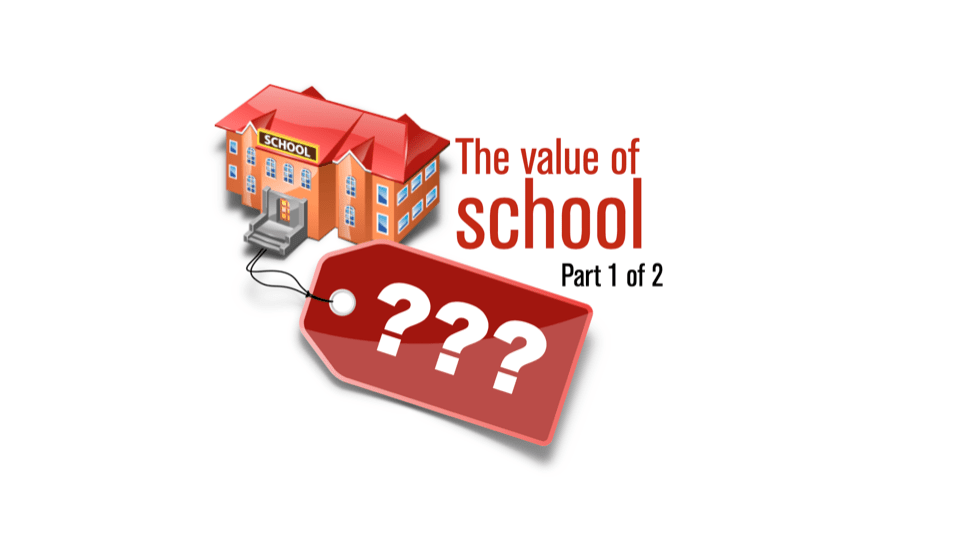Note: This is the first of two posts on the value of school by Punya Mishra & Kevin Close. Read the second post: Revisiting Accountability.
What value do schools bring?
The accepted assumption is that schools are sites for learning and the role of educators to equip students with the knowledge and skills they need to be successful in the future. One argument is:
The fundamental outcome desired for education is that it will pass on to each child the information and skills they will use throughout their lifetime. At its core, every school is a place where children learn what adults in the community already know, a place for the transmission of knowledge
Mitra (2011): The social and economic benefits of public education
This is also reflected in the manner in which we evaluate schools and teachers. We give the students tests to figure out how much they have learned, against some externally developed criteria of how much they should know by what age. And we hold students and schools accountable for this through a variety of accumulated test results.
But, what if this entire assumption (that schools are sites for learning) is wrong (or incomplete).
If there is a silver lining to the current COVID19 crisis it is that it has forced us to look at school differently. With over 97% of the world’s learners out of school, it has given us an opportunity to revisit the whole idea of what the value of school is in our social, cultural and economic lives. We list a few of these ideas below.

Schools keep kids safe so that adults can go about their business running the economy.
We would argue that the first and foremost value that schools bring to our world is an economic one. And we do not mean it in an “investment in the future” sense, which is the typical argument made for investing in public education. For instance, Hanushek argues that
When students learn more in school, they remain in the educational system longer and become more-skilled and -effective participants in the state’s workforce.
Hanushek (2016): It pays to improve school quality
In other words, Mitra suggests that:
A population that is better educated has less unemployment, reduced dependence on public assistance programs, and greater tax revenue.
From Mitra (2011): The social and economic benefits of public education
To be clear, we are not arguing against the longer-term economic value of education. But we are suggesting, rather, that there is a more significant immediate economic value that schools provide, that has become apparent due to the crisis. In blunt terms: Schools allow parents to do the work of keeping the economy humming, what Jeffrey Young describes as the custodial aspect of schooling. He writes that schools:
… take children and keep them safe and keep them secure and feed them, and whether a school is quote “good” or quote “bad,” whether the test scores are high or the test scores are low, pretty much at every school in the country parents can send their child and be secure that at the end of the day they will get their child back. And I think probably every parent in America, that’s what they’re missing.
Young (2020): What Will K-12 Schools Look Like Post-Coronavirus?
The abrupt disappearance of this custodial aspect has significant economic implications. Epstein and Hammond have calculated that the cost of closing all schools and formal day-care centers in the US is approximately around .1 to .3% of GDP, which equates to more than 50 billion dollars (give or take a few billion).
The impact of these school closures is felt most by people who are already in precarious financial situation. The cost to society is exacerbated when we consider health-care workers (especially in health crises like we have now) where it is estimated that up to 19% of health care workers would not be able to go to work if they had to take care of their children.
So, if we have to put a value on school we need to take this multi-billion dollar immediate economic benefit into account.

Schools provide environments for emotional, civic and social development
As Dr. Damian Bebell’s research on school mission statements demonstrates that, “in almost every community, school means more than just curricular content and academic learning.” Though academic/cognitive development plays an important role in school mission statements it is not as dominant as emotional, civic and social development.
Teachers and educators become like second parents, or at least role models to students, providing them nurture and support as they grow and develop. Educators get to know students as developing individuals, helping them grow as humans and citizens.
Schools are also intensely social spaces. Ask any kid and they will tell you that schools provide places for friendship and company. There is a reason why kids wait in anticipation for recess like cats ready to pounce. During play, students learn to work with others, learn about navigating differences (cultural, economic, and more).
Schools are the petri dishes for our democracy. They are often the only places where students can explore alternative professional identities (from science to art in a variety of ways, whether in the classroom or through clubs and other social organizations). Schools allow students to experience play and creativity in relatively low-risk ways, whether in formal or informal contexts whether in the playground or through participation in more formal organizations such as art and music clubs. Students also can engage in leadership activities through sports, participation in student groups and more.
And maybe most importantly, students form their first real relationships. They make friends and cliques, and break up. They fall in love and break up. Most first relationships start at school. Ideas about love and relationships that have a huge influence on the future are often formed through conversations and experiences at school.

Schools are hubs for social welfare programs, often for those with the greatest need.
Apart from the social value of schools, making friends and learning to get along with others, living in a community, developing personal qualities, schools are usually the first line of defense against the ravages of poverty. For instance, in the United States, around 100,000 schools/institutions serve free or reduced-price lunch to approximately 26 million children. For many this is the only consistent source of nutrition. Globally, 368 million children are now missing out on school meals.
The bigger issue is that schools today function as centers for social welfare programs—free and reduced lunch being just one of many initiatives. Head Start is another such program, providing provide early access to education and health programs for young low-income students. Other programs include parent education programs, recovery coaches for substance-abusing parents, programs that offer technical courses and internships, programs that provide free books, and countless prevention education programs ranging from teen pregnancy to criminal behavior. All of these programs use schools as staging grounds.

Schools bring communities together.
Schools play an important role in bringing together the community. Consider the role school sports or arts programs play in bringing the community together. School sports often become points of pride for the community. School plays and activities populate the social calendar. Schools also play a role in introducing new ideas into the community, for example, by hosting maker-fairs, visiting speakers, or other similar gatherings.

Schools address the unique and specific needs of all learners
Many parents rely on teachers and counselors with advanced training to help navigate social and academic growth. This is particularly important for students with special needs, or those navigating learning in a second language. School counselors or teachers often have expertise assessing particular learning disabilities. Once assessed, teachers and counselors not only provide advice for treatment to parents, they also help parents navigate the complex systems for receiving governmental assistance.
The silver lining
If there is a silver lining to this current crisis it is that, we can no longer ignore the fact that schools do so much more than teach. As we have argued above, schools do a lot for the communities they are in, and for the broader nation—not merely the delivery of disciplinary content. Or as Richard Culatta said in an interview:
Content, you know, that is just a really thin veneer of the overall education experience.”
Since the crisis began and schools shut down across the world, parents (and other stakeholders) have begun to realize that schools play so many roles in society besides just teaching students academic skills. Articles about school bus routes being used to drop food off for students are part of the new narrative about schools. This more holistic picture of the purpose of schools play in society also suggests that we revisit the manner in which we evaluate the value of schools, since it changes the notion of what a school should be accountable for (and how this accountability is to be measured).
We will dig deeper into this issue in the next blog post.




0 Comments
Trackbacks/Pingbacks